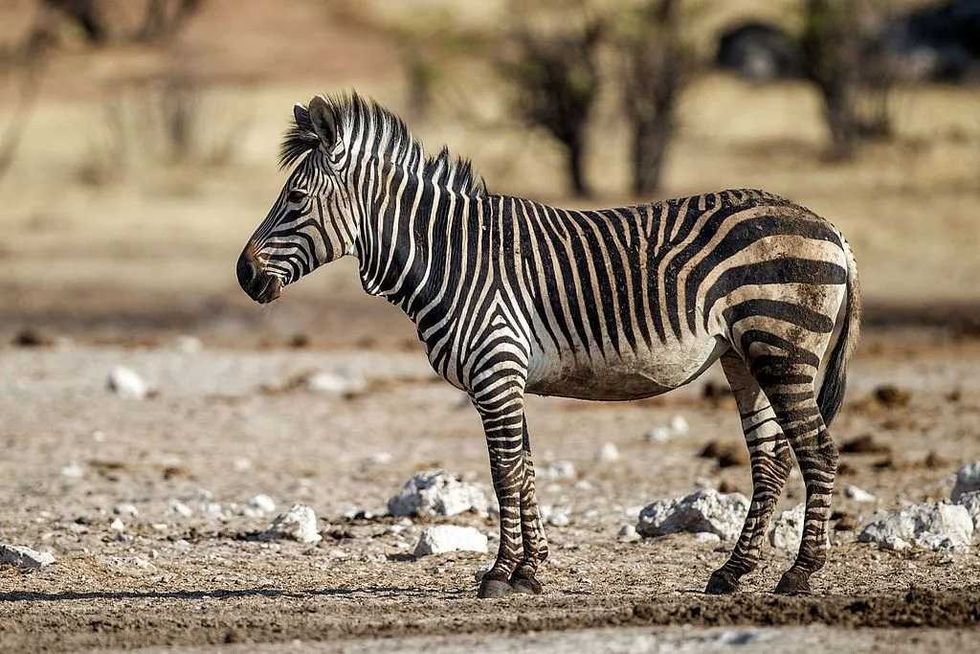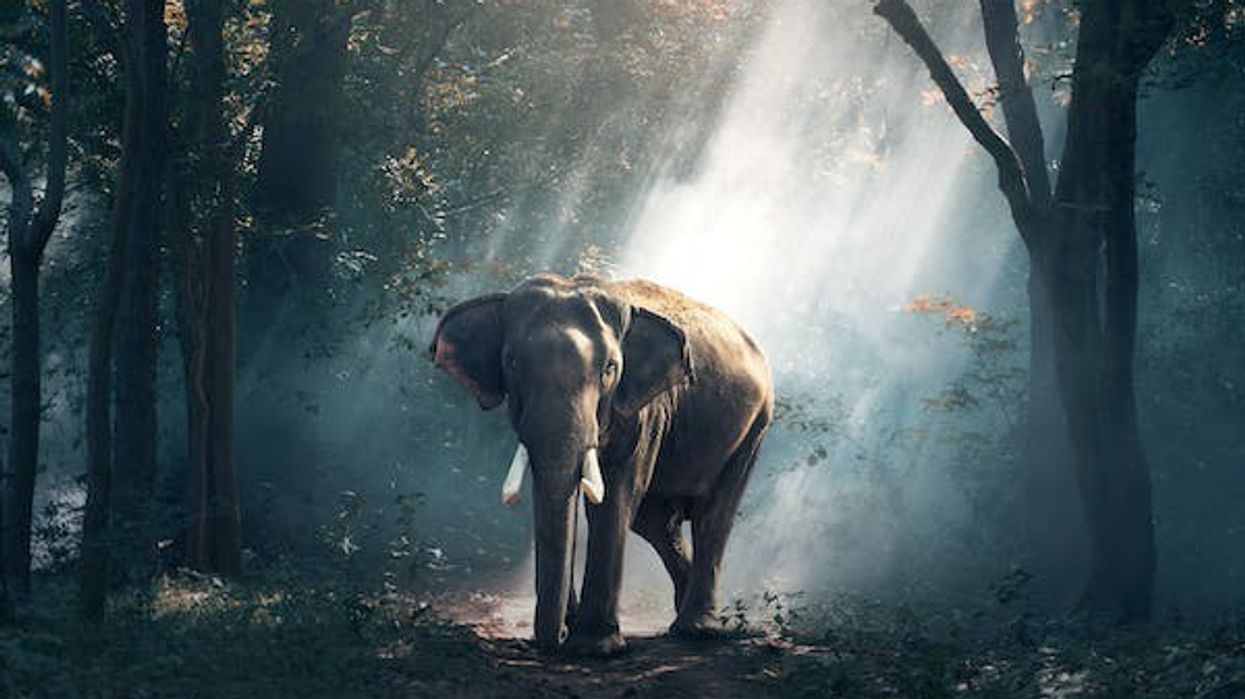The Hartmann's mountain zebra (Equus zebra hartmannae) is one of the two subspecies of the mountain zebra (Equus zebra), the other subspecies being the Cape mountain zebra (Equus zebra).
The two subspecies were once considered two separate species but further research has led to the two species being reclassified as subspecies again. Hartmann's mountain zebras are found in the slopes and plateaus of mountainous areas in Angola, Namibia, and South Africa.
They have around four subpopulations spread across Africa and are also found in a number of conservation areas and national parks.
These zebras are able to live in arid conditions better than other species of zebras but have to rely on areas with water sources.
These animals are also surprisingly good climbers because of their hard and pointed hooves. A significant part of the population of these mountain zebras is present in commercial farmlands, and their numbers are said to be increasing throughout their range.
However, there are still many threats to their species, the biggest one being any future droughts which might lead to a loss of their habitat as they are dependent on water for their survival.
If you want to enjoy more facts about other mammals, check out our mountain zebra facts and snow leopard facts pages.
Hartmann's Mountain Zebra Interesting Facts
What type of animal is Hartmann's mountain zebra?
A Hartmann's mountain zebra is a type of zebra.
What class of animal does a Hartmann's mountain zebra belong to?
This species of zebra belongs to the class Mammalia, family Equidae, and genus Equus.
How many Hartmann's mountain zebras are there in the world?
Though they suffered a major population loss and risked extinction in the 1980s, these animals have recovered remarkably due to the creation of conservancies in the areas where Hartmann's mountain zebras are found. In 2014, their total population was estimated to be around 33,000 individuals, and the population trend is increasing.
Where does a Hartmann's mountain zebra live?
The Hartmann's mountain zebra lives in the escarpment region in western Namibia, which extends north into southwestern Angola as well. This escarpment region lies between the dry coastal plain, including the Namib Desert, and a wetter inland plateau.
It also extends towards the south into the north of South Africa. Their total population in Africa is divided into four subpopulations, but they have also been established in a number of conservancies and national parks both outside and inside their geographical range.
What is a Hartmann's mountain zebra's habitat?
These mountain zebras are known to prefer mountainous areas as these areas have a lot of springs that can provide water to them throughout the year.
They inhabit slopes and plateaus up to 6,560 ft (3,000 m) above sea level.
Although they usually eat in the morning and late afternoon, in more populated areas, they will stay in the mountains or hills in the day and only descend at night to graze.
They can be considered a migratory species as they make seasonal movements, going from higher altitudes to lower altitudes and to east-facing slopes to warm up with the rising sun.
In places where artificial sources of water have been provided for them, they might be seen in a plains habitat but still like to stay near the mountains.
Who do Hartmann's mountain zebras live with?
Hartmann's mountain zebras form breeding groups like a small herd or harem of 7-12 zebras, which is a social structure observed in plains zebras (Equus quagga) as well. These harems of E. z. hartmannae generally consist of one adult stallion, one to five mares along with their dependent young.
There are nonbreeding groups as well, which consist of male juveniles or bachelors.
These bachelors stay in that group until they are around six years old, after which they form a harem of their own. A few harems can also come together to form a big herd of up to 30 zebras for the purposes of migration.
How long does a Hartmann's mountain zebra live?
In the wild, the lifespan of a Hartmann's mountain zebra is said to be more than 20 years. In one case, a zebra of this species lived up to 29 years in captivity!
How do they reproduce?
There is no particular breeding season for these mountain zebras as they can reproduce at any time of the year. Mares become sexually mature at the age of three and give birth to their first foal around that age.
They continue to give birth to a foal every one to three years from that point.
The gestation period in this species lasts up to one year. While female young are kept with the harem till they become adult mares, male foals are forced out of the group when another foal is born in the group.
What is their conservation status?
There is a high risk of droughts which can harm the population of mountain zebras by degrading their habitat. They are also vulnerable to hunting and poaching by human beings. Thus, they have been listed as Vulnerable by the IUCN Red List.
Hartmann's Mountain Zebra Fun Facts
What do Hartmann's mountain zebras look like?
A Hartmann's mountain zebra has black stripes all over its off-white body, except for the stomach, which is unstriped and white or off-white in color.
These stripes continue up till the short hair that is present over their necks, and they have gridiron stripes on their rump. The necks of these animals have a fold of skin, called a dewlap, which is unique to this species.
Their hooves are hard and pointed, to help them climb steep slopes and hills with ease, and their pointed ears can be 8-11 in (20-28 cm).
How cute are they?
These zebras are extremely cute with their wavy black and white stripes, and their foals will surely win over your heart at first sight.
How do they communicate?
Although there is not enough information available about the means of communication between mountain zebras, they are known to react and respond to the alarm call of the wildebeest so as to save themselves and their herd from any predator that other animals might have been startled by.
How big is a Hartmann's mountain zebra?
An adult Hartmann's mountain zebra's body length can be 82-102 in (2-2.5 m) and they can grow up to 45-59 in (1.1-1.4 m) tall. They are slightly bigger than the Cape mountain zebra.
How fast can a Hartmann's mountain zebra run?
Mountain zebras have been seen running at speeds of 40 mph (64 kph).
How much does a Hartmann's mountain zebra weigh?
While an adult stallion can weigh up to 756 lb (343 kg), mares typically weigh less than them at about 608 lb (276 kg).
What are the male and female names of the species?
An adult male of this species is called a stallion, and an adult female is called a mare.
What would you call a baby Hartmann's mountain zebra?
A baby Hartmann's mountain zebra (Equus zebra hartmannae) is called a foal. These foals can get up and start walking around mere hours after they are born, which is common in horses too!
What do they eat?
While in their natural habitat, these animals are known to graze on grasses in a zig-zag pattern, but will also feed on shrubs and leaves. If they are kept in a zoo, they might also be fed grain and pellets.
They have a number of predators in the wild such as lions, cheetahs, spotted hyenas, and leopards.
Are they dangerous?
This zebra species can be considered somewhat dangerous as they have been known for attacking humans when approached. Thus, it would be recommended to only gaze at them from a safe distance.
Would they make a good pet?
Though zebras have, in the past, been trained to pull chariots and carts, their bodies have not been bred for this purpose, and they are known to be a little aggressive towards humans as well.
Did you know...
The vision of this zebra species is supposed to be as good as an owl's at night, which could be of great help when looking out for predators who might be out for a hunt at night!
What are the three types of zebra?
There are three main species of zebras, all living in eastern and southern Africa: the plains zebra, the Grevy's zebra, and the mountain zebra. All of them have black and white stripes on their bodies with some differences.
The plains zebra is the one that is most commonly found out of the three, while the Grevy's zebra has the least population among them. Both the plains and Grevy's zebras prefer grasslands, but the mountain zebras would rather run to higher altitudes in case of any danger and stay there.
What is the behavior of a mountain zebra?
The Hartmann's mountain zebra is said to be very active in the morning and late afternoon, particularly to graze. These zebras need to drink water once or twice a day, and with the rise in availability of artificial water sources, these animals have been able to expand their range into lowland areas as well.
They have also been witnessed playing among themselves in zoos.
Here at Kidadl, we have carefully created lots of interesting family-friendly animal facts for everyone to discover! Learn more about some other mammals from our spiral-horned antelope facts or jaguar facts pages.
You can even occupy yourself at home by coloring in one of our free printable Hartmann's mountain zebra coloring pages.









